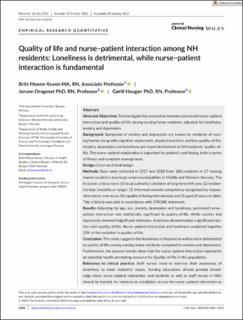| dc.contributor.author | Kuven, Britt Moene | |
| dc.contributor.author | Drageset, Jorunn | |
| dc.contributor.author | Haugan, Gørill | |
| dc.date.accessioned | 2024-02-02T13:08:50Z | |
| dc.date.available | 2024-02-02T13:08:50Z | |
| dc.date.created | 2023-01-20T11:20:32Z | |
| dc.date.issued | 2023 | |
| dc.identifier.citation | Journal of Clinical Nursing (JCN). 2023, 32, (17-18), 5417-6759 | en_US |
| dc.identifier.issn | 0962-1067 | |
| dc.identifier.uri | https://hdl.handle.net/11250/3115318 | |
| dc.description | This is an open access article under the terms of the Creative Commons Attribution-NonCommercial-NoDerivs License, which permits use and distribution in any medium, provided the original work is properly cited, the use is non-commercial and no modifications or adaptations are made. | en_US |
| dc.description.abstract | Background: Symptoms of anxiety and depression are known to residents of nursing homes along with cognitive impairment, physical inactivity and low quality-of-life. Anxiety, depression and loneliness are found detrimental to NH residents' quality-of-life. The nurse–patient relationship is important for patient's well-being, both in terms of illness and symptom management.
Design: Cross-sectional design.
Methods: Data were collected in 2017 and 2018 from 188 residents in 27 nursing homes resided in two large urban municipalities in Middle and Western Norway. The inclusion criteria were: (1) local authority's decision of long-term NH care; (2) residential stay 3 months or longer; (3) informed consent competency recognised by responsible doctor and nurse; (4) capable of being interviewed, and (5) aged 65 years or older. This article is executed in accordance with STROBE statement.
Results: Adjusting for age, sex, anxiety, depression and loneliness, perceived nurse–patient interaction was statistically significant to quality-of-life. While anxiety and depression showed insignificant estimates, loneliness demonstrated a significant relation with quality-of-life. Nurse–patient interaction and loneliness explained together 25% of the variation in quality-of-life.
Conclusion: This study suggests that loneliness is frequent as well as more detrimental to quality-of-life among nursing home residents compared to anxiety and depression. Furthermore, the present results show that the nurse–patient interaction represents an essential health-promoting resource for Quality-of-life in this population.
Relevance to clinical practice: Staff nurses need to exercise their awareness of loneliness to meet residents' needs. Nursing educations should provide knowledge about nurse–patient interaction, and students as well as staff nurses in NHs should be trained, for instance by simulation, to use the nurse–patient interaction as a health-promoting resource. Finally, loneliness represents a bigger challenge than depression and anxiety; accordingly, building nurses that are capable of meeting patients' needs and facilitate care that counteracts loneliness is highly warranted. | en_US |
| dc.language.iso | eng | en_US |
| dc.publisher | John Wiley & Sons | en_US |
| dc.rights | Attribution-NonCommercial-NoDerivatives 4.0 Internasjonal | * |
| dc.rights.uri | http://creativecommons.org/licenses/by-nc-nd/4.0/deed.no | * |
| dc.subject | well-being | en_US |
| dc.subject | quality of life | en_US |
| dc.subject | older people | en_US |
| dc.subject | nursing homes | en_US |
| dc.subject | nurse-patient interaction | en_US |
| dc.title | Quality of life and nurse–patient interaction among NH residents: Loneliness is detrimental, while nurse–patient interaction is fundamental | en_US |
| dc.type | Peer reviewed | en_US |
| dc.type | Journal article | en_US |
| dc.description.version | publishedVersion | en_US |
| dc.rights.holder | © 2023 The Authors. Journal of Clinical Nursing published by John Wiley & Sons Ltd | en_US |
| dc.source.pagenumber | 5417-6759 | en_US |
| dc.source.volume | 32 | en_US |
| dc.source.journal | Journal of Clinical Nursing (JCN) | en_US |
| dc.source.issue | 17-18 | en_US |
| dc.identifier.doi | 10.1111/jocn.16645 | |
| dc.identifier.cristin | 2111375 | |
| cristin.ispublished | true | |
| cristin.fulltext | original | |
| cristin.qualitycode | 2 | |

